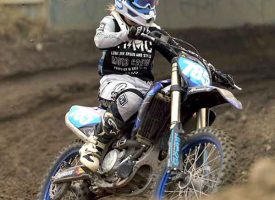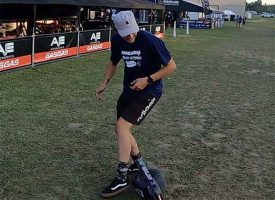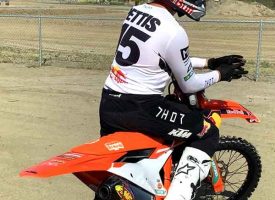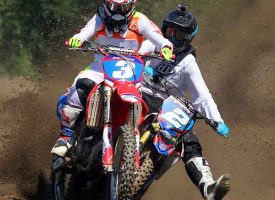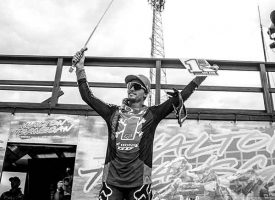Finding Answers: Making the Case for Safety
By Brett Lee
With everything that has happened lately regarding injuries and worse, Walton Raceway owner, Brett Lee, has stepped forward in an attempt to bring about change in the way we handle crashes and the resulting injuries. When he asked if he could write a guest column on the topic, there was no hesitation. Brett always has insightful opinions and is a crafty writer, so we jumped at the opportunity to hear from him on this important topic.
From Kevin Windham‘s (kdub_14) Instagram this morning:
I am a promoter in Canada and a former racer. When a rider gets hurt, or worse, when a rider gets hurt on your track, it is a painful weight to carry. Those events come with a heavy sense of guilt and responsibility. It is something that has been the hardest part of my career; the part I have struggled with the most. Racers who drive through our gates are people we know personally, and those I don’t know, I relate to intimately through the love of this sport.
I have been fortunate to cover Canadian motocross from coast to coast, working with different tracks, promoters, clubs and racers throughout the years. I have made a career out of motocross. When I was a small kid dreaming of racing and riding bikes, I never dreamed I would be in the position I now hold and doing what I do. Now that my own racing is behind me, and each morning my ankle reminds me why I am a better spectator, my jersey hanging framed in my basement reminds me of why I would do it all over again.
What I think about now is the future of the sport. I have two kids. My oldest is 13 and he saved his own money to buy his first bike last fall. He has a track, more connections to the sport than I ever did at his age, and, more than anything, he wants to race. The thought and the emotion of my own son racing, coupled with him racing at our farm, is exciting when thinking of the highs associated with motocross, but I’m also very anxious when thinking about the devastating lows that can also follow.
The injuries witnessed from Detroit on televisions across the country are dull and light compared to the heartbreak felt at Freestone MX in Wortham, Texas, this past weekend. What is common after the past few days is the fear and concern raised by these incidents. It all comes from the united desire to better what we love and pushes us to ask everyone how to prevent, or reduce, what will invariably happen again.
Safety and what can be done becomes the conversation of the week. Web forums, social media, tracks, and shops become places of debate. Not just in small circles, but across the entire sport and around the world, which is good. It is a topic that needs all hands together to make progress that is real.
There are big things that could change the safety of the sport: bike size and track design are two that seem obvious, but, unfortunately, are very difficult to gain any consensus on and change. Manufacturers are years out from changing bikes, tracks are scattered, not really connected and heavily influenced by supercross. I had a promoter once tell us he needed big jumps for spectators and that motocross was an “extreme” sport. He was told to turn around and look at the pits: it is a family sport.
In my own experience, one of the biggest hurdles I have run into when questioning any of this is who holds the liability and understanding of what the issues are. Is it bikes, gear, tracks, speed? There is no clear point. The number of opinions match the number of people involved. And while the opinions may come from some of the most respected people in our sport they are still opinions without proven facts to support them, and, unfortunately, will prevent important action. At the top of this, the decision-makers are very hesitant to enforce rules limiting or mandating rules around safety. Ask why chest protectors are not mandatory…because there is limited science around what works, the regulations and cost associated with implementing a ruling and then the fear of the resulting liability if something happens. Real questions and concerns without clear answers.
So, I have believed for a long time that we need science, facts and understanding of how and why crashes happen and the impact of those crashes. I strongly believe one of the things that is a missing link in motocross around the world is an understanding of what makes our sport safe. With crashes, especially resulting in fatalities like this weekend, no one seems to talk about the actual crash. We pick up the pieces and move on. It is part of our sport. We are all tight and to dig into the details of it seems to be a cold approach to a sad situation.
We need to have a shared place where we can document crashes and injuries that allow for us to make the sport safer. Detail the conditions: Was it dusty, muddy, watered? Type of event: Regional, Amateur National, Pro National? Experience of track designer? Was it in the morning, the afternoon, at night? Did it happen in practice–first or second– timed qualifier or not? Moto one or moto two? If a racing crash, what position, previous results? Was he pushing him/herself? What was the bike size? Bike condition prior to crash? Bike condition after the crash? Photos? What was the rider’s age? What was the rider’s skill? Vet, Pro, Beginner? What was the rider’s condition prior? Did he have any injuries? Was the rider using any type of medication? What was the rider wearing? Helmet, neck protection, chest protection, types/brands? And photos of the equipment, and perhaps a place to send it for inspection? What was the track type? Supercross, outdoors, arenacross, man-made? The type of medic and response time? What are some eyewitness reports on the crash?
This type of information is sometimes gathered in ‘official’ investigations when lawsuits are pending. However, we, as racers, promoters, sanctioning bodies and organizations need have these questions asked to understand how to make the entire sport, whether it is supercross or a local race, safer. If we can draw links between safety equipment, bikes, riders, tracks, state of mind of competitor etc., then we can create profiles of the entire incident and make sound conclusions that can steer the sport in a safer direction with real information to make these decisions.
I believe this could be started as a website that riders themselves populate their information and experience. Update crash or injuries information in a pull-down menu that allow trends to be identified. Provide race medics with common forms that can be documented at tracks that are gathered then logged. If after a year we can give a profile of what the average rider looks like, what the average crash/injury is, then we can move in a direction to reduce, prevent, and minimize crashes and subsequent injuries. Not just reduce the catastrophic injuries, but reduce that which we calmly accept as just ‘part of racing.’ At this point, we have so little to go on other than guesswork and speculation.
To make really big change, it is going to take information and solid research presented by those with a big enough audience to make all take notice. It is going to take an entire industry buy-in to push for meaningful change with sound reasoning to support it. I am in: for myself, my event, my kid, and my customers. I want to understand what works, what doesn’t and what makes this all better.



